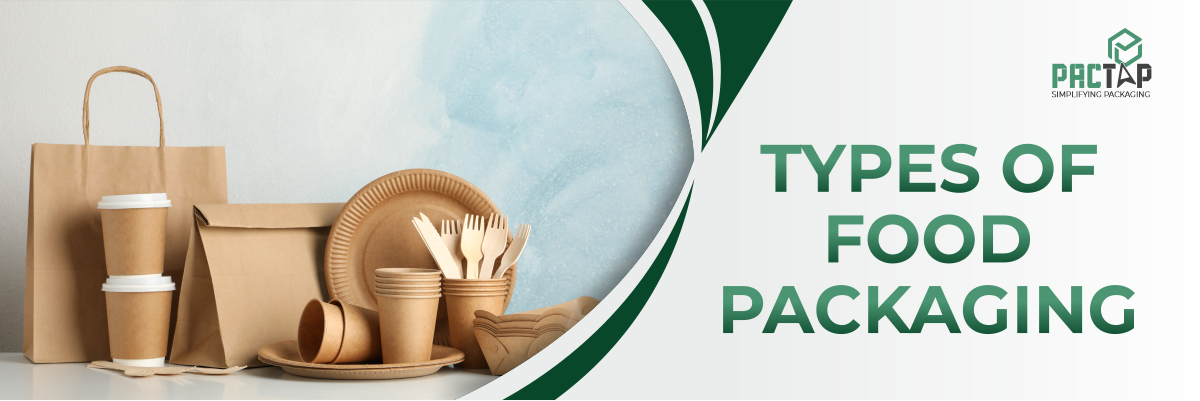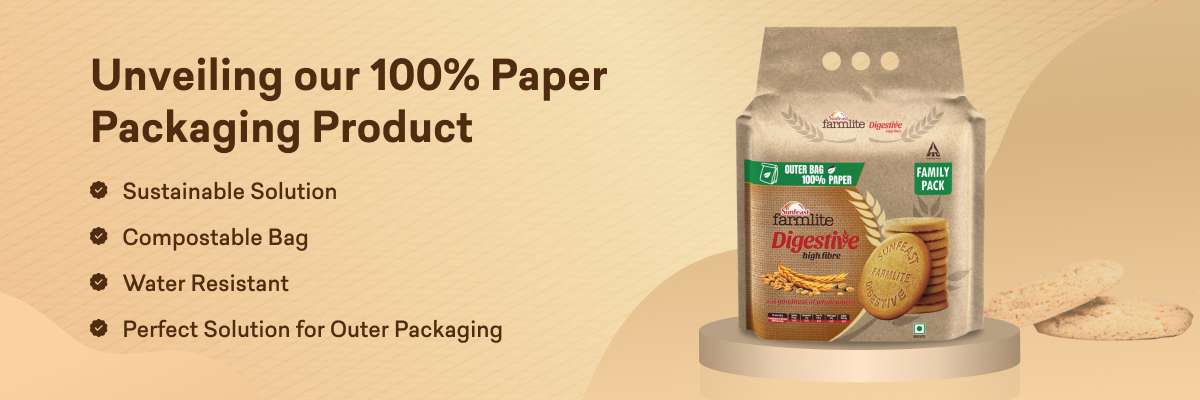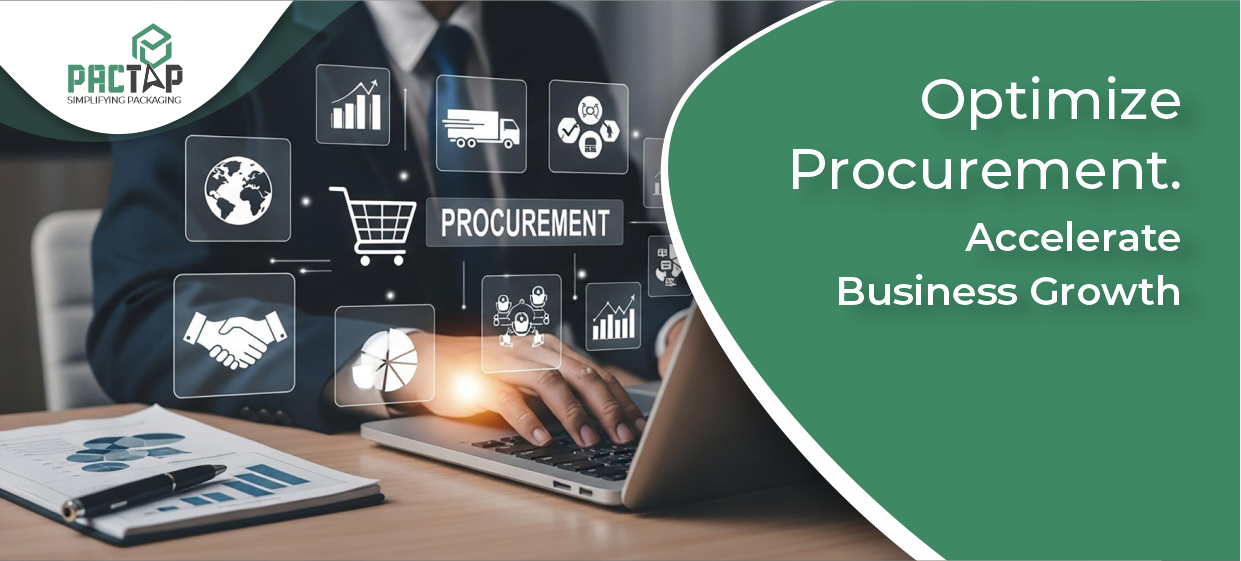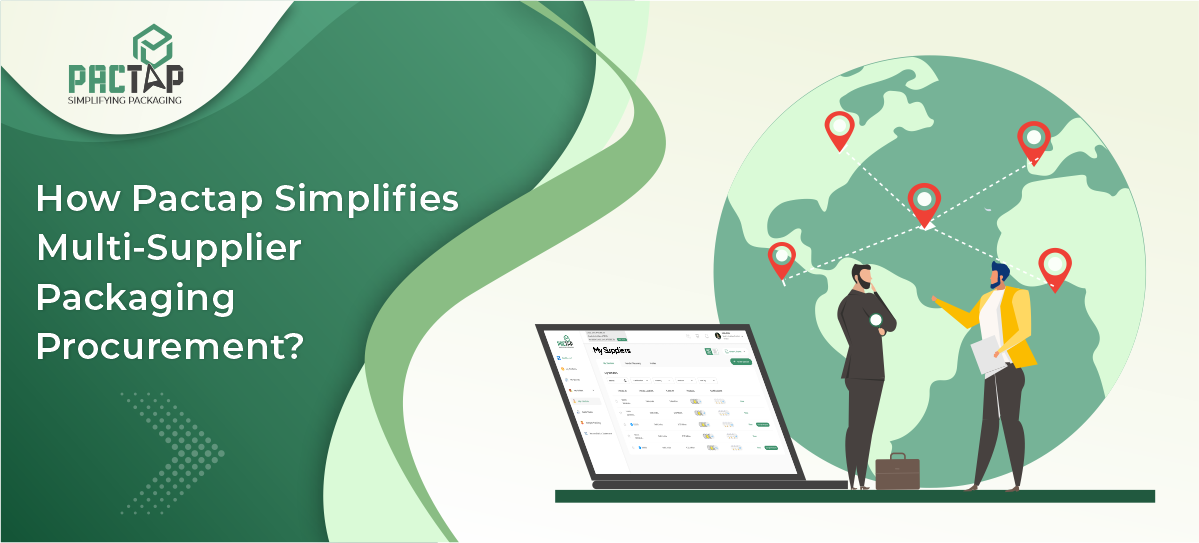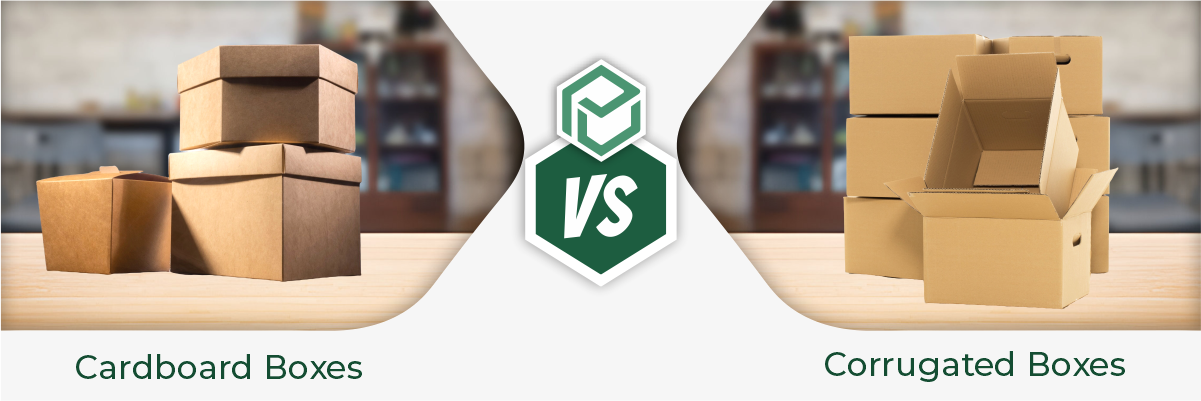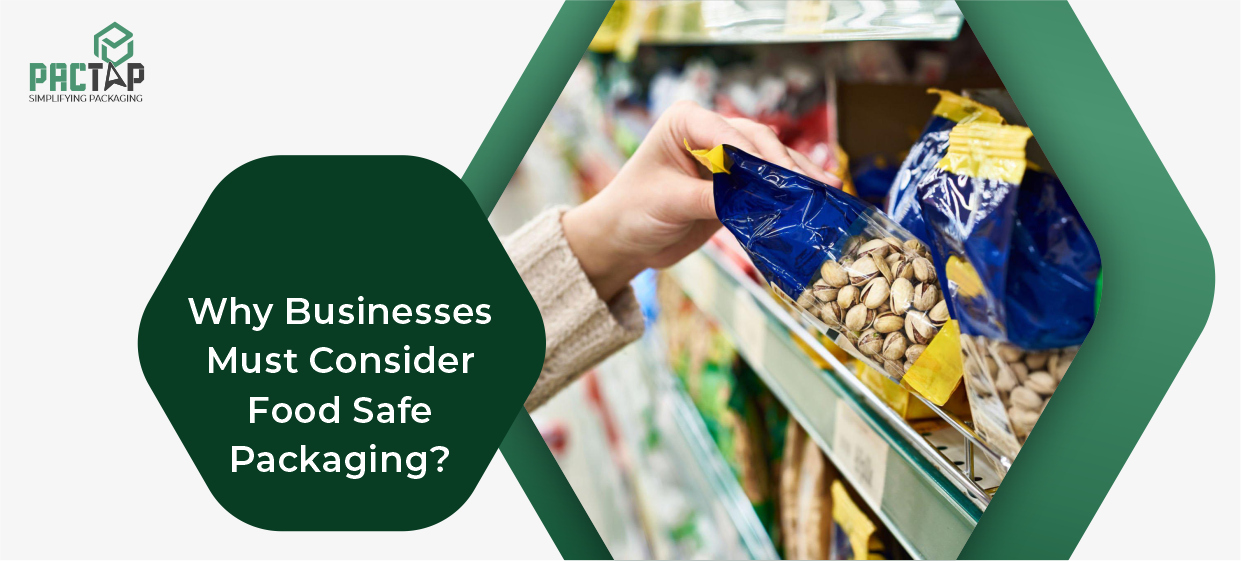Food packaging plays an important role in our daily lives. It goes beyond simply containing food; it’s a silent guardian angel. It protects food from spoilage, preserving its freshness and quality from farm to fork.
Packaging also acts as an informative billboard, communicating ingredients, nutritional value, and even potential allergens. But its influence doesn’t stop there. Eye-catching designs and creative marketing messages emblazoned on packaging can entice us to choose one product over another.
This guide delves into the fascinating world of food packaging, exploring the diverse types of materials used, their specific applications, and the multitude of benefits they offer businesses, ensuring food safety, maximizing shelf life, and even influencing consumer choices.
What are the Food Packaging Materials?
Food packaging plays a crucial role in preserving and protecting food products from manufacturing to consumption. Understanding the various materials used in food packaging is essential for making informed choices and considering their environmental impact. Here’s a more detailed explanation of the common food packaging materials:
Paper and Cardboard
Paper and cardboard are popular choices for food packaging due to their sustainability, versatility, and ease of recycling. Made from renewable resources, these materials are often used for cereal boxes, cracker boxes, and beverage cartons. They provide good printability, allowing for clear branding and product information. Some varieties are wax-coated to enhance moisture resistance, making them suitable for packaging products with slightly higher moisture content.
Plastics
Plastics are made up of a variety of materials, each with its own set of characteristics. PET (polyethylene terephthalate), HDPE (high-density polyethylene), and PVC (polyvinyl chloride) are among the most common. Plastics offer advantages such as flexibility, durability, and transparency, making them suitable for packaging liquids, snacks, and products requiring visibility. However, the environmental concerns surrounding plastic waste have led to a push for more sustainable options, such as recyclable and biodegradable plastics.
Glass
Glass is valued for its inertness, meaning it does not react with the food it contains. This feature helps preserve the freshness and flavor of food goods. Glass is commonly used for jars, bottles, and containers, particularly for liquids, sauces, and products requiring an extended shelf life. Glass’s transparency increases a product’s appeal by letting customers see what’s inside. However, glass packaging is heavier and more fragile compared to other materials, which can impact transportation costs and handling.
Metal
Metal packaging, particularly steel cans coated with tin for corrosion resistance, is widely used for canned goods such as vegetables, fruits, and meats. Metal offers excellent protection against light, oxygen, and spoilage, ensuring a long shelf life for the products inside. The robustness of metal packaging makes it suitable for harsh transportation conditions. However, metal cans are heavier compared to other packaging materials and require specific recycling processes to recover the materials.
Biodegradable
Biodegradable materials are a growing trend in food packaging as they offer a more sustainable alternative to traditional materials. These materials can decompose naturally in the environment, reducing their impact on landfills. Common biodegradable materials used in food packaging include cornstarch, sugarcane, and wood pulp. Biodegradable packaging is frequently used for single-use products including straws, cups, and cutlery.
What are the Advantages and Disadvantages of Each Food Packaging Material?
Food packaging material selection is influenced by a number of variables, including the product’s nature, shelf life, and environmental impact. The advantages and disadvantages of typical packing materials will be examined.
| Material | Advantages | Disadvantages |
|---|---|---|
| Plastic | Versatile, durable, cost-effective | Environmental concerns, potential health risks |
| Paper/Cardboard | Recyclable, biodegradable | Less durable, susceptible to moisture |
| Metal | Durable, good barrier properties | Heavy, less versatile |
| Glass | High clarity, reusable, recyclable | Heavy, fragile |
| Biodegradable | Environmentally friendly | It may have limited durability or a higher cost |
What are the Different Types of Food Packaging and Their Applications?
Choosing the right food packaging goes beyond aesthetics; it’s about finding the perfect fit for your product’s needs. Let’s explore the two main categories of food packaging – rigid and flexible – and delve into their specific applications:
Rigid Packaging: The Stalwart Protectors
Rigid packaging offers a sturdy and secure environment for your food products. These are some important kinds and how they are used:
- Boxes: Cardboard boxes are champions for dry goods. They are perfect for cereals, spaghetti, and snacks because of their versatility. Aseptic cartons, a special type of paperboard box with an aluminum lining, are heroes for shelf-stable milk and juice, extending their shelf life significantly.
- Cans: When it comes to long-lasting preservation, metal cans reign supreme. Typically made from steel coated with tin, they provide exceptional protection against light, oxygen, and contamination. This makes them the go-to choice for canned vegetables, fruits, shelf-stable soups, and condensed milk.
- Tubs and Cups: Plastic tubs and cups offer a versatile solution for various food products. They come in both rigid and semi-rigid varieties, making them suitable for yogurt, margarine, and deli salads. Some even boast microwave-safe functionality, adding to their convenience.
- Glass Jars: Looking for a premium and reusable option? Glass jars are your answer. They offer excellent clarity, allowing consumers to see the product before purchase, and are ideal for jams, jellies, sauces, and pickles.
Flexible Packaging: The Adaptable Guardians
Flexible packaging provides a lightweight and adaptable solution for food items. The following are a few popular kinds and their potential uses::
- Pouches and Doypacks: These stand-up pouches, crafted from laminated plastic films, are popular for snacks, nuts, and condiments. Their lightweight nature and printability make them ideal for showcasing branding and product information.
- Bags: Plastic bags are workhorses in the packaging world. They provide a moisture barrier for chips, bread, and fresh produce. Additionally, resealable options promote extended freshness for products that need it most.
- Wraps: Plastic wrap and aluminum foil are the ultimate cling artists. They offer exceptional protection against air exposure, making them perfect for wrapping meats, cheeses, and fruits, ensuring they stay fresh for longer.
Beyond the Basics: Specialized Packaging Solutions
Beyond the core categories, several specialized packaging options cater to specific needs:
- Blister Packs: These pre-formed plastic trays with peelable foil backing offer individual serving portions for cheese, cold cuts, and baked goods, promoting convenience and reducing waste.
- Trays and Punnets: Shallow plastic containers with lids are the go-to choice for fresh produce. They offer excellent visibility, allowing consumers to assess product quality, and facilitate stacking for efficient storage and display.
- Resealable Pouches: These pouches come equipped with a ziplock closure, making them ideal for products like cheese, deli meats, and frozen vegetables. They provide the convenience of resealing, promoting portion control, and preventing spoilage.
Benefits of Food Packaging for Businesses
Food packaging goes beyond just wrapping your product. It’s a silent guardian, offering a multitude of advantages for businesses:
- Extended Shelf Life: Packaging acts as a barrier against oxygen, moisture, light, and contamination, the enemies of food spoilage. This extended shelf life allows businesses to reduce waste and reach a wider audience with their products.
- Preserved Quality: Packaging safeguards food from physical damage like crushing and leaks. This ensures consumers receive a fresh and appealing product, fostering brand loyalty and trust.
- Portion Control Convenience: Pre-measured and pre-portioned packaging offers convenience for consumers. This reduces waste and caters to single-serving needs, making your product more versatile.
- Branding and Marketing Powerhouse: Packaging is a silent salesperson. Eye-catching designs, clear labeling, and informative descriptions can attract consumers and influence purchasing decisions. It’s your chance to tell your brand story and stand out on the shelf.
- Tamper-Evident Trust Builders: Packaging can incorporate tamper-evident seals or closures. This visible security measure reassures consumers about product safety and reinforces brand commitment to quality.
- Safe and Efficient Transportation & Storage: Packaging facilitates safe and efficient transportation and storage of food products. It acts as a protective layer during handling and distribution, ensuring your product arrives fresh and intact.
How to Choose the Right Food Packaging?
Food packaging is more than just aesthetics; it’s about finding the ideal match for your product’s specific needs. Here are some critical elements to consider when making your decision:
- Food Properties: Understanding your food is crucial. Does it require moisture control to prevent spoilage, like baked goods? Or maybe light protection for delicate oils? Matching your packaging properties to your food’s needs ensures optimal preservation and extends shelf life.
- Shelf Life Considerations: Think about how long you want your product to last on store shelves. Aseptic cartons, with their extended shelf life capabilities, are perfect for long-lasting milk. On the other hand, resealable pouches offer convenience and freshness for products consumed at home.
- Target Audience Matters: Who do you want to reach? Eco-conscious consumers may appreciate packaging made from recycled paperboard or compostable plastics. Conversely, a premium glass jar might resonate with those seeking high-quality products. Aligning packaging with your target market’s values can strengthen brand image and influence purchasing decisions.
- Cost-Effectiveness: A Balancing Act: Finding the right balance between cost and value is essential. While some materials may be cheaper upfront, consider long-term factors like durability, printability for branding, and recyclability. A package that protects your product well and minimizes waste can lead to cost savings in the long run.
- Sustainability: A Responsibility, An Opportunity: Environmental impact is a growing concern. Whenever possible, use recyclable, biodegradable, or compostable materials. This not only demonstrates your commitment to environmental responsibility but can also attract eco-conscious consumers who prioritize sustainable practices.
Regulations and Compliance
Food packaging isn’t just about functionality; it must comply with regulations to ensure food safety and consumer trust. Here’s a breakdown of key areas these regulations address:
- Food-Grade Materials: Only materials designated as “food-grade” can come in direct contact with food. This ensures they are safe for consumption and won’t contaminate your product.
- Clear and Accurate Labeling: Packaging must be transparent and communicative. Clear labeling contains ingredients, nutritional information, allergen warnings, and expiration dates. This enables customers to make informed judgments.
- Migration Testing: This crucial step ensures chemicals from the packaging material don’t migrate into the food at harmful levels. It safeguards food safety and protects consumer health.
What is the Future of Food Packaging?
The world of food packaging is constantly innovating, driven by a desire for sustainability and a commitment to better serve both consumers and the environment. Here are a few notable trends that will influence the future.
- Biodegradable and Compostable Materials: Move over, traditional plastics! Bio-based and compostable materials are gaining traction. These eco-friendly options offer a sustainable alternative, reducing reliance on landfills and minimizing environmental impact.
- Smart Packaging: A Sensory Revolution: Imagine packaging that “talks” to you! The integration of sensors and indicators into packaging is on the rise. This “smart packaging” can monitor food quality, freshness, and even temperature during transport and storage, providing valuable data to ensure optimal food safety.
- Active Packaging: Taking Food Protection to the Next Level: Active packaging goes beyond simply containing food. It incorporates materials that actively interact with the product. These materials can extend shelf life, absorb oxygen to prevent spoilage, or even release beneficial antioxidants.
- Minimalist Packaging: Less is More: The focus on reducing waste extends to the packaging itself. A trend towards minimalist packaging is emerging, with the development of more efficient and lightweight solutions that use minimal materials while still offering optimal protection for food products.
What are the 4 Types of Food Packaging?
There are 4 main types of food packaging for the food itself (primary packaging):
- Rigid: Cardboard boxes, metal cans, and glass jars offer sturdy protection.
- Flexible: Plastic wraps, bags, and pouches form around food for a snug fit.
- Aseptic: Special cartons with multiple layers keep food fresh without refrigeration.
- Paperboard: Think cereal boxes and juice cartons, offering structure and information.
Which Type of Food Packaging Keeps Food Most Fresh?
Packaging that effectively blocks out oxygen, light, and moisture is typically best for preserving food freshness. This can include:
- Vacuum Sealing: Removes air from the package, preventing oxidation.
- Modified Atmosphere Packaging (MAP): Replaces air with a mixture of gases to slow down spoilage.
- High-Barrier Films: These films have low permeability to gases and moisture, helping to maintain product quality.
Conclusion
Food packaging plays a vital role in our food system, ensuring food safety, quality, and convenience. By understanding the various types of packaging materials, their applications, and the factors influencing packaging selection, businesses can make informed decisions that benefit both their products and the environment. As the industry embraces innovation and sustainability, we can expect even more exciting developments in food packaging that minimize waste and maximize food enjoyment.
